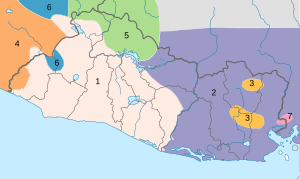Pipil people facts for kids

Nahua family in Sonsonate, El Salvador.
|
|
| Total population | |
|---|---|
| ~12,000 | |
| Regions with significant populations | |
| Western and central El Salvador | |
| Estimated 12,000 | |
| 6,388 | |
| Languages | |
| Nawat (Nahuat), Salvadoran Spanish | |
| Religion | |
| Christianity (Predominantly Roman Catholic) and Traditional Indigenous Customs | |
| Related ethnic groups | |
| Nahuas, Nicarao people, Lenca | |
The Nahua people are an Indigenous group. They live in the western and central parts of El Salvador today. They speak the Nawat language, which is part of the Nahuan language family. Not many people speak Nawat anymore. Because of this, there are efforts to help more people learn and use the language again.
The Nahua people have beliefs about the world and universe. These beliefs are similar to those of the Toltec, Maya, and Lenca cultures.
Contents
Understanding the Nahua Language

The word Nahua describes groups of people who speak Nahuan languages. You might also hear them called Pipil. This name, Pipil, comes from the Nahuatl word pil, meaning "boy." Some people thought the Aztecs used "Pipil" to suggest Nawat was a simpler version of their own language, Nahuatl. However, the Nahua people do not call themselves Pipil.
Some experts believe Pipil might mean "noble." They think the Spanish and their allies used this name for the important leaders. These leaders were called the Pipiltin and owned land.
Nawat is mainly spoken in Central America. It is different from other Nahuan languages spoken in Mexico.
Where Nawat is Spoken Today
Today, Nawat is not used by many people. It is mostly spoken in rural areas. You can hear phrases in homes, especially in the Sonsonate and Ahuachapán areas. The towns of Cuisnahuat and Santo Domingo de Guzmán have the most Nawat speakers.
In the 1980s, only about 200 people spoke Nawat. It was hard to count them because many Indigenous Salvadorans were afraid to say they spoke the language. This fear came from a sad event in 1932 called La Matanza ("The Massacre"). During this time, many Indigenous Salvadorans faced great challenges. This event caused many to stop teaching their language and traditions to their children. They also stopped wearing traditional clothes out of fear.
However, things are changing! Thanks to efforts by groups and universities, the number of Nawat speakers grew to 3,000 by 2009. Many of these new speakers are young people. This is helping to save the language from disappearing. People are working hard to bring Nawat back to life, both in El Salvador and in other countries.
Nahua History and Culture

Stories from the Nahua people say they moved from what is now Mexico. They arrived in El Salvador around the 8th century A.D. When they settled, they founded a city-state called Kūskatan. Other groups like the Lenca and Maya already lived there.
The Nahua people were skilled workers. They made cotton textiles and traded them widely. They also grew crops, especially cacao, which is used to make chocolate. Their cacao farms in the Izalco area were very successful. They had a large irrigation system to water their crops. Their trade network reached far north to Teotihuacan and south to Costa Rica.
When the Spanish arrived in the 1500s, they found the Nahua people in western El Salvador and southeastern Guatemala. Some Nahua towns grew into modern cities, like Sonsonate and Ahuachapán.
The Spanish Arrival
In the early 1500s, Spanish explorers came to Central America. They wanted to expand their control. Pedro de Alvarado, a Spanish leader, led an invasion in 1524. He had many allies from other Indigenous groups. The Nahua warriors fought bravely against the Spanish. They even forced the Spanish army to retreat at first.
The Spanish eventually returned with more soldiers. The Nahua forces moved into the mountains. They continued to fight against the Spanish and their allies. It took several more Spanish expeditions to fully take control of Kūskatan.
Legend says a Nahua leader named Atlácatl and Lord Atunal Tut led the Nahua fighters. One famous battle was the Battle of Acajutla, led by Atunal.
After the Spanish won, the Nahua people became part of the Spanish system. The Spanish stopped calling them Pipil and just called them indios (Indians). Today, scholars use "Pipil" to talk about the Indigenous people in El Salvador. However, the Indigenous people themselves prefer to use terms like "Nawataketza" (a Nawat speaker) or simply "indígenas" (Indigenous).
Modern Nahua Culture
Many people in El Salvador feel a connection to the Nahua people. About 86% of Salvadorans identify as Mestizos, meaning they have mixed Indigenous and European heritage. A smaller group, about 1-4%, are of mostly Indigenous background.
Today, there are still Indigenous people who speak Nawat and follow traditional ways of life. They mostly live in the northwestern highlands. However, many self-identified Indigenous people live in other areas too.
There is a growing interest in keeping traditional Indigenous customs alive. Indigenous communities are now more willing to perform their ceremonies in public. They also feel safer wearing traditional Indigenous clothing. This shows a strong revival of Nahua identity and pride in El Salvador.
Notable Nahua People
- Anastasio Aquino (1792–1833), a Nonualco war chief
- Prudencia Ayala (1885–1936), an activist for Indigenous rights
- Feliciano Ama (1881–1932), a chief from Izalco
- Francisco "Chico" Sánchez, a chief from Juayua
- Nantzin Paula López Witzapan, a poet and Nawat language expert (1959-2016)
- Alicia Maria Siu, a mural artist
Related articles
See also
 In Spanish: Pipil para niños
In Spanish: Pipil para niños
- El Mozote massacre (1981), a sad event during the Salvadoran Civil War.
- La Matanza (1932), an Indigenous resistance that led to many Indigenous people facing challenges.
- Annals of the Cakchiquels (1571), a historical book written in the Kaqchikel language.
- Pipil language
- Pipil language (typological overview)
- Pipil grammar

